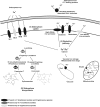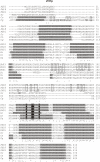The homeostasis of iron, copper, and zinc in paracoccidioides brasiliensis, cryptococcus neoformans var. Grubii, and cryptococcus gattii: a comparative analysis
- PMID: 21833306
- PMCID: PMC3153025
- DOI: 10.3389/fmicb.2011.00049
The homeostasis of iron, copper, and zinc in paracoccidioides brasiliensis, cryptococcus neoformans var. Grubii, and cryptococcus gattii: a comparative analysis
Abstract
Iron, copper, and zinc are essential for all living organisms. Moreover, the homeostasis of these metals is vital to microorganisms during pathogenic interactions with a host. Most pathogens have developed specific mechanisms for the uptake of micronutrients from their hosts in order to counteract the low availability of essential ions in infected tissues. We report here an analysis of genes potentially involved in iron, copper, and zinc uptake and homeostasis in the fungal pathogens Paracoccidioides brasiliensis, Cryptococcus neoformans var. grubii, and Cryptococcus gattii. Although prior studies have identified certain aspects of metal regulation in Cryptococcus species, little is known regarding the regulation of these elements in P. brasiliensis. We also present amino acid sequences analyses of deduced proteins in order to examine possible conserved domains. The genomic data reveals, for the first time, genes associated to iron, copper, and zinc assimilation and homeostasis in P. brasiliensis. Furthermore, analyses of the three fungal species identified homologs to genes associated with high-affinity uptake systems, vacuolar and mitochondrial iron storage, copper uptake and reduction, and zinc assimilation. However, homologs to genes involved in siderophore production were only found in P. brasiliensis. Interestingly, in silico analysis of the genomes of P. brasiliensisPb01, Pb03, and Pb18 revealed significant differences in the presence and/or number of genes involved in metal homeostasis, such as in genes related to iron reduction and oxidation. The broad analyses of the genomes of P. brasiliensis, C. neoformans var. grubii, and C. gattii for genes involved in metal homeostasis provide important groundwork for numerous interesting future areas of investigation that are required in order to validate and explore the function of the identified genes and gene pathways.
Keywords: infection; micronutrient homeostasis; pathogenic fungi.
Figures





Similar articles
-
Experimental systemic infection with Cryptococcus neoformans var. grubii and Cryptococcus gattii in normal and immunodeficient mice.Med Mycol. 2006 Nov;44(7):601-10. doi: 10.1080/13693780600810040. Med Mycol. 2006. PMID: 17071553
-
A unique chromosomal rearrangement in the Cryptococcus neoformans var. grubii type strain enhances key phenotypes associated with virulence.mBio. 2012 Feb 28;3(2):e00310-11. doi: 10.1128/mBio.00310-11. Print 2012. mBio. 2012. PMID: 22375073 Free PMC article.
-
Seasonal variations in the prevalence of Cryptococcus neoformans var. grubii and Cryptococcus gattii in decayed wood inside trunk hollows of diverse tree species in north-western India: a retrospective study.Med Mycol. 2011 Apr;49(3):320-3. doi: 10.3109/13693786.2010.516457. Epub 2010 Sep 21. Med Mycol. 2011. PMID: 20854229
-
Environmental prevalence of Cryptococcus neoformans and Cryptococcus gattii in India: an update.Crit Rev Microbiol. 2012 Feb;38(1):1-16. doi: 10.3109/1040841X.2011.606426. Epub 2011 Dec 1. Crit Rev Microbiol. 2012. PMID: 22133016 Review.
-
Recognition of seven species in the Cryptococcus gattii/Cryptococcus neoformans species complex.Fungal Genet Biol. 2015 May;78:16-48. doi: 10.1016/j.fgb.2015.02.009. Epub 2015 Feb 23. Fungal Genet Biol. 2015. PMID: 25721988 Review.
Cited by
-
An encapsulation of iron homeostasis and virulence in Cryptococcus neoformans.Trends Microbiol. 2013 Sep;21(9):457-65. doi: 10.1016/j.tim.2013.05.007. Epub 2013 Jun 25. Trends Microbiol. 2013. PMID: 23810126 Free PMC article. Review.
-
Proteomic analysis reveals that iron availability alters the metabolic status of the pathogenic fungus Paracoccidioides brasiliensis.PLoS One. 2011;6(7):e22810. doi: 10.1371/journal.pone.0022810. Epub 2011 Jul 28. PLoS One. 2011. PMID: 21829521 Free PMC article.
-
Identification of membrane proteome of Paracoccidioides lutzii and its regulation by zinc.Future Sci OA. 2017 Jul 25;3(4):FSO232. doi: 10.4155/fsoa-2017-0044. eCollection 2017 Nov. Future Sci OA. 2017. PMID: 29134119 Free PMC article.
-
Paracoccidioides spp. ferrous and ferric iron assimilation pathways.Front Microbiol. 2015 Aug 12;6:821. doi: 10.3389/fmicb.2015.00821. eCollection 2015. Front Microbiol. 2015. PMID: 26441843 Free PMC article.
-
Alterations of protein expression in conditions of copper-deprivation for Paracoccidioides lutzii in the presence of extracellular matrix components.BMC Microbiol. 2014 Dec 13;14:302. doi: 10.1186/s12866-014-0302-7. BMC Microbiol. 2014. PMID: 25609357 Free PMC article.
References
-
- Arango R., Restrepo A. (1988). Growth and production of iron chelants by Paracoccidioides brasiliensis mycelial and yeast forms. J. Med. Vet. Mycol. 26, 113–118 - PubMed
-
- Bailão A. M., Schrank A., Borges C. L., Dutra V., Molinari-Madlum E. E. W. I., Felipe M. S. S., Mendes-Giannini M. J. S., Martins W. S., Pereira M., Soares C. M. A. (2006). Differential gene expression by Paracoccidioides brasiliensis in host interaction conditions: representational difference analysis identifies candidate genes associated with fungal pathogenesis. Microbes Infect. 8, 2686–269710.1016/j.micinf.2006.07.019 - DOI - PubMed
-
- Bailão A. M., Shrank A., Borges C. L., Parente J. A., Dutra V., Felipe M. S., Fiuza R. B., Pereira M., Soares C. M. A. (2007). The transcriptional profile of Paracoccidioides brasiliensis yeast cells is influenced by human plasma. FEMS Immunol. Med. Microbiol. 51, 43–57 - PubMed
-
- Banci L., Bertini I., Chasapis C. T., Rosato A., Tenori L. (2007). Interaction of the two soluble metal-binding domains of yeast Ccc2 with copper(I)-Atx1. Biochem. Biophys. Res. Commun. 364, 645–649 - PubMed
LinkOut - more resources
Full Text Sources

